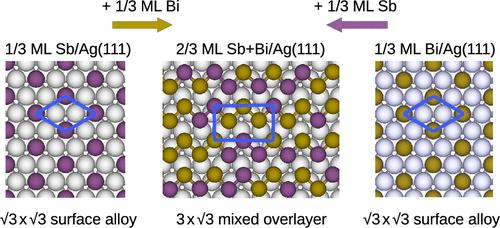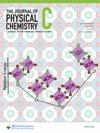Single-Layer of Bi1–xSbx Grown on Ag(111)
IF 3.3
3区 化学
Q2 CHEMISTRY, PHYSICAL
引用次数: 0
Abstract
In this work, we report the growth of a mixed Bi1–x Sbx single layer on the Ag(111) surface with various stoichiometries. The atomic geometry has been thoroughly investigated by low-energy electron diffraction, scanning tunneling microscopy, and X-ray photoelectron spectroscopy experiments, as well as calculations based on density functional theory. We first determined that the Sb/Ag(111) system for coverages below 2/3 monolayer behaves similarly to the Bi/Ag(111) system, with a dealloying transition to a rectangular (3 × √3) phase when the Sb coverage exceeds 1/3 monolayer. We found two alternative preparation strategies to obtain a mixed Bi1–x Sbx layer: sequential deposition and simultaneous deposition of Bi and Sb. In the first case, one of the elements is deposited on a completely covered surface alloy of the other element. The obtained phase corresponds to a single mixed BiSb layer free of Ag atoms, forming a rectangular (3 × √3) structure. The simultaneous deposition strategy yields the same structure but offers the significant advantage of enabling controlled variation of the stoichiometry. The obtained mixed Bi–Sb phase has a lateral atomic arrangement very similar to the one in the nonalloyed phase observed for Sb on Ag(111), with Sb and Bi atoms distributed disorderly, and presents a significant vertical corrugation, promising considerable Rashba effects.

生长在 Ag(111) 上的单层 Bi1-xSbx
在这项研究中,我们报告了在 Ag(111)表面上生长的具有不同化学计量的 Bi1-x Sbx 混合单层。通过低能电子衍射、扫描隧道显微镜和 X 射线光电子能谱实验以及基于密度泛函理论的计算,我们对原子几何结构进行了深入研究。我们首先确定了覆盖率低于 2/3 单层的锑/银(111)体系与铋/银(111)体系的表现类似,当锑的覆盖率超过 1/3 单层时,锑/银(111)体系会向矩形(3 × √3)相过渡。我们发现了获得 Bi1-x Sbx 混合层的两种备选制备策略:顺序沉积和同时沉积 Bi 和 Sb。在第一种情况下,其中一种元素沉积在另一种元素完全覆盖的合金表面上。得到的相位相当于一个不含银原子的单一混合铋锑层,形成一个矩形(3 × √3)结构。同时沉积策略产生了相同的结构,但其显著优势在于可以控制化学计量的变化。所获得的铋锑混合相的横向原子排列与在 Ag(111) 上观察到的铋非合金相的原子排列非常相似,铋原子和铋原子无序分布,并呈现出明显的垂直波纹,有望产生相当大的拉什巴效应。
本文章由计算机程序翻译,如有差异,请以英文原文为准。
求助全文
约1分钟内获得全文
求助全文
来源期刊

The Journal of Physical Chemistry C
化学-材料科学:综合
CiteScore
6.50
自引率
8.10%
发文量
2047
审稿时长
1.8 months
期刊介绍:
The Journal of Physical Chemistry A/B/C is devoted to reporting new and original experimental and theoretical basic research of interest to physical chemists, biophysical chemists, and chemical physicists.
 求助内容:
求助内容: 应助结果提醒方式:
应助结果提醒方式:


